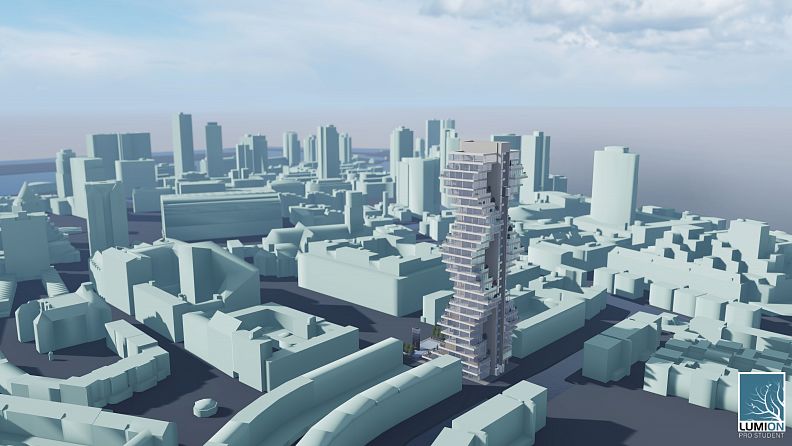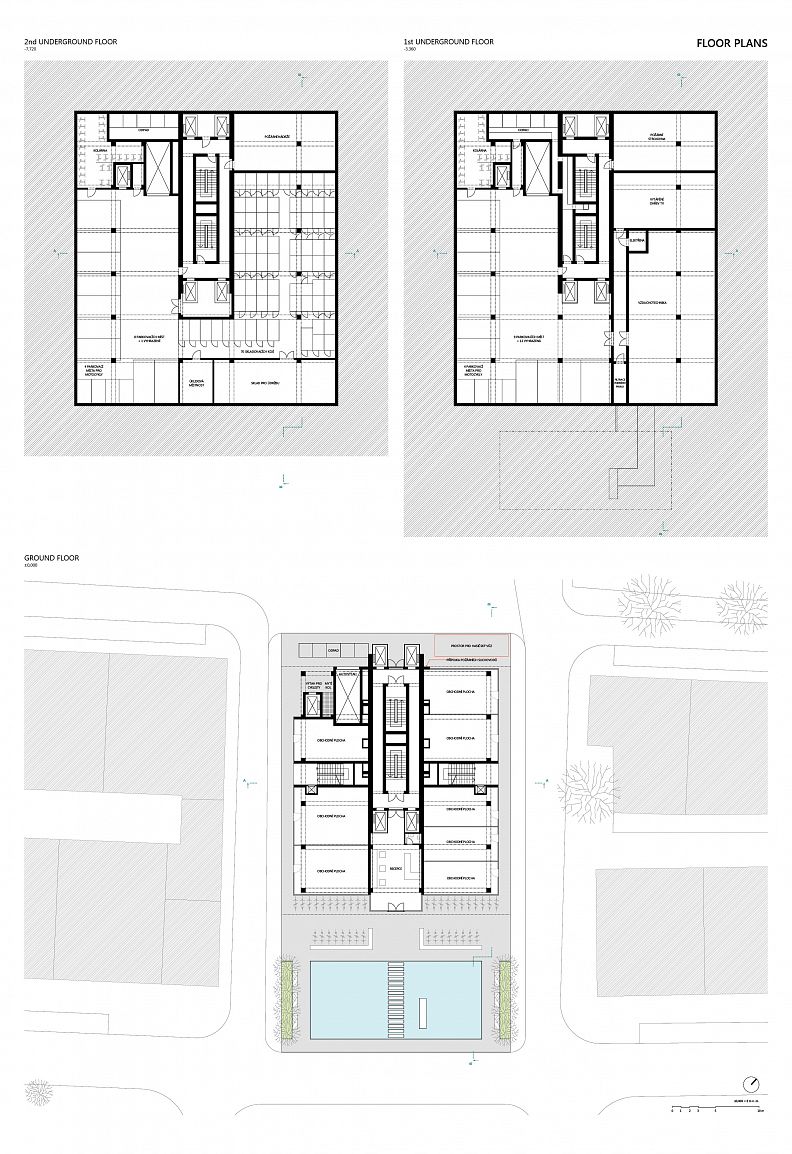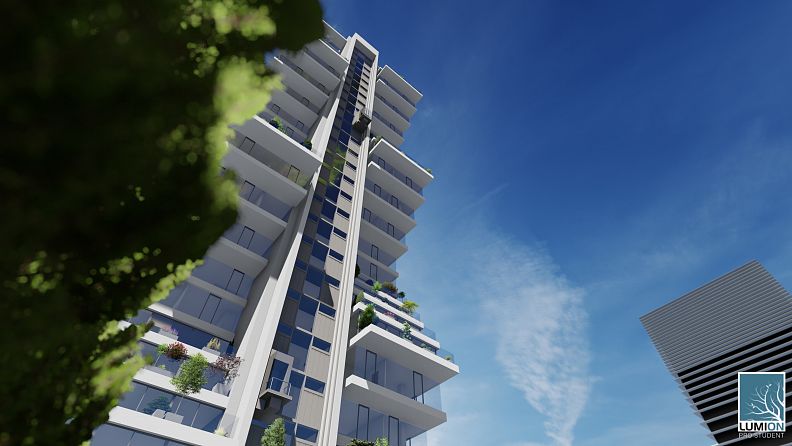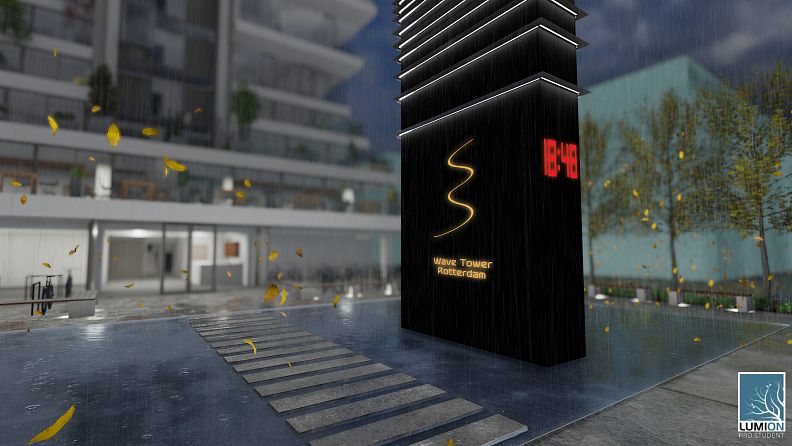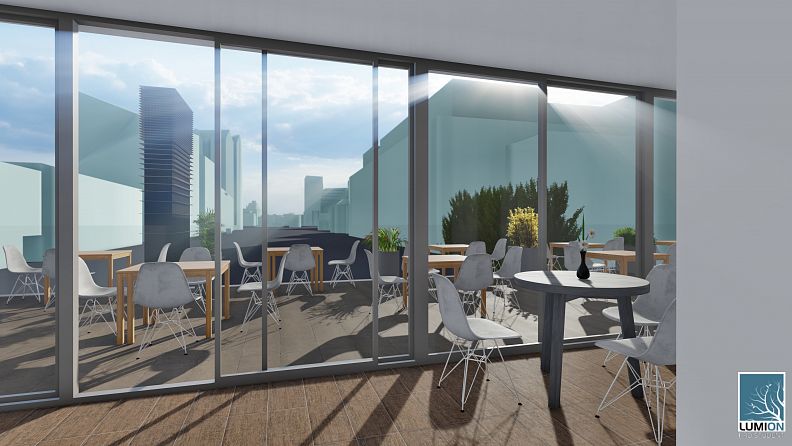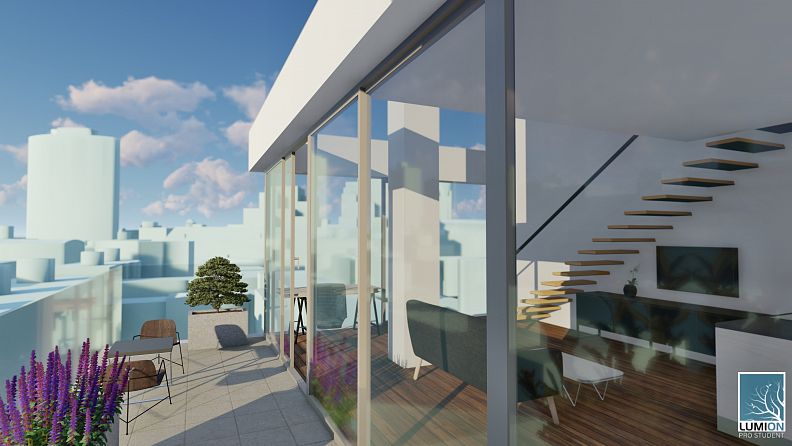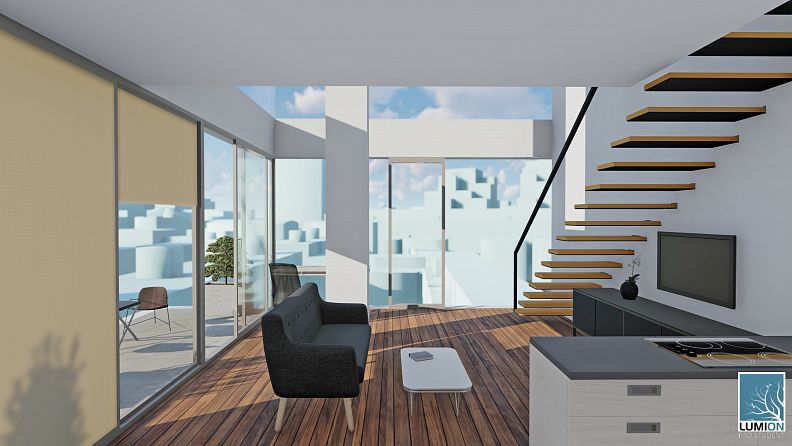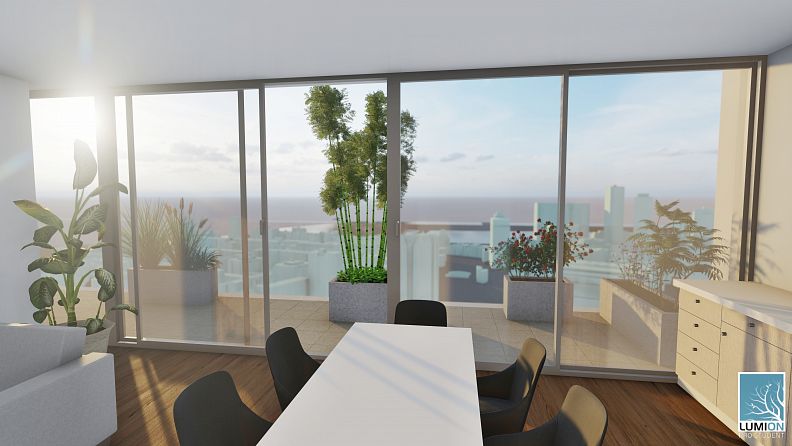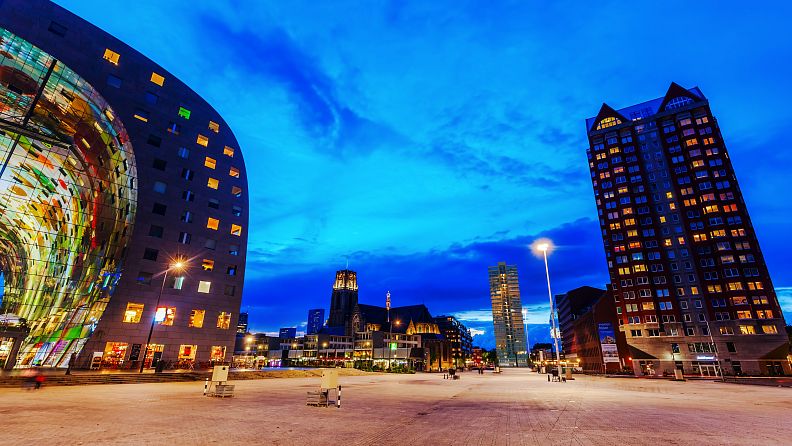Wave Tower Rotterdam

Project idea
The project deals with the design of a residential building in the center of Rotterdam, on a plot located at the end of the Binnenrotte square. The challenge of the project is to succeed in the context of distinctive modern buildings in the area and create a new landmark. The mass of the building is oriented vertically. The individual floors gradually recede, creating terraces and the dynamic character of the building. The main idea of the project is to create spaces that can be variably divided according to the needs of the investor. The glass facade allows almost unlimited panoramic views of the city.
Project description
Characteristics of the territory
Land intended for residential housing is a direct part of the center of Rotterdam - Binnenrotte Square. At present, it serves as a parking lot, which is, in my opinion, a pity for the place exposed at the head of the square. The aim of the project is to design a landmark that closes the northwestern end of the square, becomes a landmark and highlights the axis of the square. The building should be another iconic building in the center of Rotterdam. The surrounding buildings have different heights. There are buildings up to 100 meters high. The high-rise building at this location will not be unsuitable. Large cities are still evolving and new architecture must respond to this.
Mass and functional division
The assignment does not limit the mass of the building in any way. I decided for a vertical mass solution for several reasons. Thanks to the height orientation of the mass, part of the land can serve as a public space. A new landmark at the head of the square and a new dominant of the center of Rotterdam is created.
I designed the resulting mass so that its dynamics correspond to the pace of life of the modern city and at the same time fit into the overall panorama of the center of Rotterdam. The building rises above a long public space and follows its axis towards the river Maas. The design of the building is based on the idea of movement - waves. The building develops from the primary block volume by transforming individual housing units by a horizontal shift along the longitudinal axis. When viewed from the square, it retains its classic rectangular shape. However, as soon as the observer moves off-axis, the mass begins to gradually ripple. For me, the waves are a symbol of rhythmic movement, the pace of life, but they also refer to the importance of water for Rotterdam. The shift of the individual floors has also a practical justification. On the one side, terraces are created and on the other side, the upper floor forms shading.
The first two floors above ground have a commercial function, above them are residential floors. The two underground floors have the operational and technical background of the building, parking and storage space. The last floor also has a technical function. The different functions do not affect the external appearance of the building. The outer shell is glazed around the entire perimeter, divided by horizontal ceiling slabs, which are visible on the facade. The height of all floors is the same. The facade thus acquires a regular rhythm. Glazing to the entire height of the rooms and especially along the entire length of the facade allows almost unlimited panoramic views of the city.
Transport solutions, communications and entrances
The main entrance to the building is from the square. Through the reception, residents walk into the communication core of the building, which has four elevators and two staircases. Elevators run along the facade. The stairs are located in the middle of the reinforced concrete cores, around which a corridor leads. From the corridor you enter the individual apartments. Commercial premises have their own entrances from the side streets. There are supply elevators designed for the operation of refreshments on the 2nd floor. The entrance to the underground car park is solved in the back of the building by a car lift from Lombardkade street. Cyclists have a lift right next door, in the west corner of the building, where they can wash their bikes. In case of rain, they are waiting for the elevator in the dry, under the roof. The bike rooms are then right next to the elevator.
Layout and operational solutions
Most layouts are intentionally variable, only the technical and operational background of the building is fixed. The idea of the project is to design a building as a framework, which the user of specific spaces then fills in and adjusts according to his needs. On the 1st floor, the reception area and elevators for cars and cyclists are designed. The rest of the floor is intended for shops and can be arbitrarily divided into larger or smaller areas. On the 2nd floor, there are also retail spaces, and compared to the assignment, I added space for a café or bistro. It can be considered as one large operation, or divided into two operations. Adjacent to this area is a large terrace. Sitting with good refreshment and a view of the square will certainly be pleasant and attractive.
The housing unit can be divided into two apartments of different sizes or a duplex apartment can be created. The only layout restrictions are fixed entrances to the apartments and supporting columns running through the interior. Thanks to the all-glass facade, it is not necessary to decide where the window will be. The glass walls are equipped with internal blinds, providing shading and privacy. Alternatively, it is possible to add curtains to the interior. Entrances to the terraces are solved by sliding glass walls. On the terraces are installed boxes of various sizes, in which it is possible to grow flowers, herbs, vegetables, bushes or even small trees. For irrigation, you can use the accumulated rainwater from the tap directly on the terrace. Vegetation on the terraces improves the microclimate of individual apartments. It cools the interior by shading, forms a sound barrier, cleans the air, produces oxygen, retains moisture and is also pleasing to the eye. Thanks to the movement from the wind, it brings an interesting animation to the interior.
Public space
The entrance hall from Binnenrotte square looks like a small square. It is bordered on the sides by flower beds with trees, in the shade of which are benches. In front of the building there are bicycle stands, which are separated from the square by a sitting area. Benches and bike stands are designed in a minimalist form. In the middle of the square is a water element - a shallow lake. You can bypass it or walk over the concrete tiles in the middle. A ten-meter column rises from the pond. On the front wall there is a digital clock. It refers to the typology of the square, headed by the town hall with a clock on the tower. Time can also be perceived as a sundial thanks to the shadow cast by the pillar into the pond. The surroundings are reflected on the water surface. An animation of the water surface by wind will be interesting. The waves distort the mirrored image and when combined with the shining sun, a caustic is created at the bottom of the lake. Rain on an water surface will also cause interesting effects. The water element will have a positive effect on the surrounding microclimate on hot and dry days.
Colors
I chose a white-gray color range with small black accents in the form of bicycle stands and a column in front of the building. The white slabs of the individual floors protrude from the facade and stand out on the gray core of the building. Moderate colors will be a good basis for greenery, which will change color during the year according to the growing season and thus enliven the entire building
Technical information
Construction solution of a building
Base constructions
The base constructions consist of a reinforced concrete slab and piles. Vertical constructions are based on piles ø1500/15000 mm and ø600/10000 mm. The base slab has a thickness of 700 mm and 1000 mm above the piles. Due to the proximity of water channels, I assume the foundation below the groundwater level. The base slab together with the perimeter walls of the basement are designed from water retaining concrete.
Vertical load bearing constructions
The vertical load bearing constructions are designed from monolithic reinforced concrete. It is a combination of column and wall construction system. The columns have a square cross-section of 500x500 mm and the two main load-bearing walls have a thickness of 500 mm. The building has two load-bearing reinforcing cores with a staircase 300 mm thick. The load-bearing walls are connected to the cores by reinforcing walls with a thickness of 300 mm. On some floors, it is not possible to maintain continuous columns. Therefore, the columns of some floors are laid on a partly wall and partly frame beam formed by a wall 500 mm thick and beams 500x500 mm, which are partly hidden in the ceiling slab.
Horizontal load bearing constructions
The horizontal load bearing structures are designed from monolithic reinforced concrete. In the underground floors and the ground floor, the construction of the ceiling is solved by beams with a cross-section of 500x500 mm, on which boards with a thickness of 250 mm are placed. In the other above-ground floors, 300 mm thick ceiling slabs are placed on the load-bearing wall and columns. The edges of slabs are cantilevered. There are installation penetrations in the slabs. The slabs of stairs and ceiling slabs of the corridor are 200 mm thick.
Vertical communication
The main vertical communication is provided by 4 elevators on the facade, of which 3 are designed as evacuation elevators and one reserves for fire intervention. Inside the two reinforced concrete cores, there are prefabricated staircases that also serve as escape staircases. Access for cars to the underground floors is provided by a car lift and for cyclists there is another lift directly adjacent to the bike rooms.
Non-load bearing constructions
Non-load bearing vertical constructions in the building are solved in several ways. There are concrete walls (fire dividing structures) in the operating facilities. The retail area can be divided by brick or plasterboard partitions. In the apartments, there is a choice of construction and material of partitions on the client. There is underfloor heating, so it is not possible to anchor anything to the floors. The facade of the vertical communication core is solved by a light perimeter cladding of aluminum profiles and insulating triple glazing. There is an elevator door in the casing. Glass panels bring daylight into corridors and staircases.
Window openings / openings and fillings in vertical load bearing constructions
In the perimeter glass shell there are sliding walls forming entrances to terraces and balconies. There are tilting windows in the firmly glazed walls.
Terraces and balconies
In most cases, the terraces are formed by a receding floor. In several cases, the balconies are formed by a console. The railing, like the perimeter walls of the housing units, is made of glass so it does not obstruct the view. The height of the railing is 1200 mm. On the terraces there are fiberton planter boxes which are secured against shifting. The range of sizes from 40 x 80 x 50 cm to 80 x 80 x 80 cm cm allows to grow from small herbs and vegetables to shrubs and small trees. The tread layer can be solved with tiles, wooden planks or modern plastics.
Technical equipment of the building
Energy concept
The building uses renewable resources for partial energy independence. Energy savings can be achieved with a photovoltaic shell or wind turbines on the roof. A heat pump is used to heat the building. The low solar factor of the glass shell reduces the cost of air conditioning. Interior blinds partially prevent the interior from overheating. Rainwater and household waste management are also solwed.
Heating
The building is heated by district heating. A heat pump made via piles can also be used to heat the building. The building has underfloor heating supplemented by floor convectors along the glass shell.
Ventilation system
The whole building uses central forced ventilation. The air conditioning and cooling engine room is on the 1st underground floor. The intake of clean air and the exhaust of the exhaust air are solved through a column in front of the building. Each apartment has its own recuperation unit, which is connected to the central supply and exhaust air led by a shaft between the staircases. The outdoor cooling units are located on the 27th floor, which is open to the exterior. It is also possible to use natural ventilation with sliding glass walls on the terraces. There are tilting windows in the firmly glazed walls of the apartments.
Water supply and sewerage
Water and sewage pipes are led through installation shafts at the inner wall of housing units. The shafts are designed to fit the length compensation of individual types of pipes. Hot water heating is solved centrally. The building is divided into 3 pressure zones. The technical rooms are on the 1st underground floor, 10th and 20th floors. There are hot water tanks and booster station for the water supply.
Rainwater management
All terraces and balconies are sloping towards the interior and drained by gutters to the wall, in which rainwater is stored and can subsequently be used to irrigate planter boxes. Dirt is prevented from entering the tank. The water flows down the slope to the lower floor, where it can be drained from the tap on the wall. The tank is equipped with an overflow into the rainwater drainage. In winter, the inlet to the tank is closed to prevent it from freezing. Rainwater collection from areas around the building is used to irrigate flower beds.
Household waste
Household waste could be dealt with in an innovative way. Waste lift system, conveyor belts and underground containers. I propose 2 underground containers 5 m3 for mixed waste and 3 halved containers for sorted waste - plastics, paper, cardboard, metal, glass and biowaste. Everything would be controlled electronically. After placing the waste bag in the elevator, the type of waste is selected on the control panel. According to this option, in the 1st underground floor, the waste is transported in conveyor belt to the appropriate container. The containers will be equipped with sensors and a signal for collection will be sent when the capacity is reached. The spaces are ventilated, automatically disinfected and have access for maintenance.
Maintenance
The maintenance warehouse is located on the 2nd underground floor. The building shell can be cleaned by specialized workers from a platform suspended on a structure above the 27th floor.
